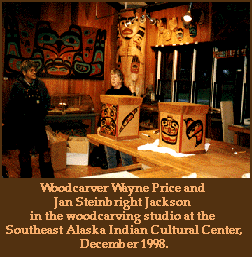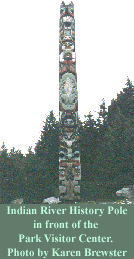 The Southeast Alaska Indian Cultural Center (SEAICC) was established in 1969 as a place for local Sitka Tlingits to teach themselves about their own culture, while also helping visitors to Sitka National Historical Park understand the tribal people whose history is part of the Park story. SEAICC is an independent Native non-profit organization, but is housed in the Park Visitor Center. At the Cultural Center, visitors view artists working and can talk to them about their art and their culture. SEAICC also offers courses in things like, beadwork, weaving, bentwood box making, and box drum making. SEAICC also sponsors special projects, like the Indian River History Totem Pole raising in 1996, and the carving of a traditional Tlingit canoe.
The Southeast Alaska Indian Cultural Center (SEAICC) was established in 1969 as a place for local Sitka Tlingits to teach themselves about their own culture, while also helping visitors to Sitka National Historical Park understand the tribal people whose history is part of the Park story. SEAICC is an independent Native non-profit organization, but is housed in the Park Visitor Center. At the Cultural Center, visitors view artists working and can talk to them about their art and their culture. SEAICC also offers courses in things like, beadwork, weaving, bentwood box making, and box drum making. SEAICC also sponsors special projects, like the Indian River History Totem Pole raising in 1996, and the carving of a traditional Tlingit canoe.
Listen to Jan Steinbright Jackson's, Irene Jimmy's and Ellen Hope Hays' interviews to hear them talk about the establishment of the Cultural Center, its importance, and the relationship between SEAICC and the National Park Service.
Listen to Louis Minard's, Irene Jimmy's, Teri Rofkar's, and Tommy Joseph's interviews to hear artists talk about their art and working at SEAICC.
 Haa leelk'u has Kaastaheendax -- Indian River History Pole
Haa leelk'u has Kaastaheendax -- Indian River History Pole
In 1996, the Cultural Center sponsored the carving and raising of a thirty-five foot totem pole in front of the Park's Visitor Center. The multi-clan pole was carved by local Sitka carvers to commemorate the Tlingit clans (Kaagwaantaan, Kiks.ádi, and Coho) who lived in the area before the Russians came. The pole's Tlingit name means "honoring our ancestors who lived along Indian River."
Listen to Dave Galanin's, Irene Jimmy's, and Louise Brady's interviews to hear them talk about the carving and raising of the Indian River History Pole.

